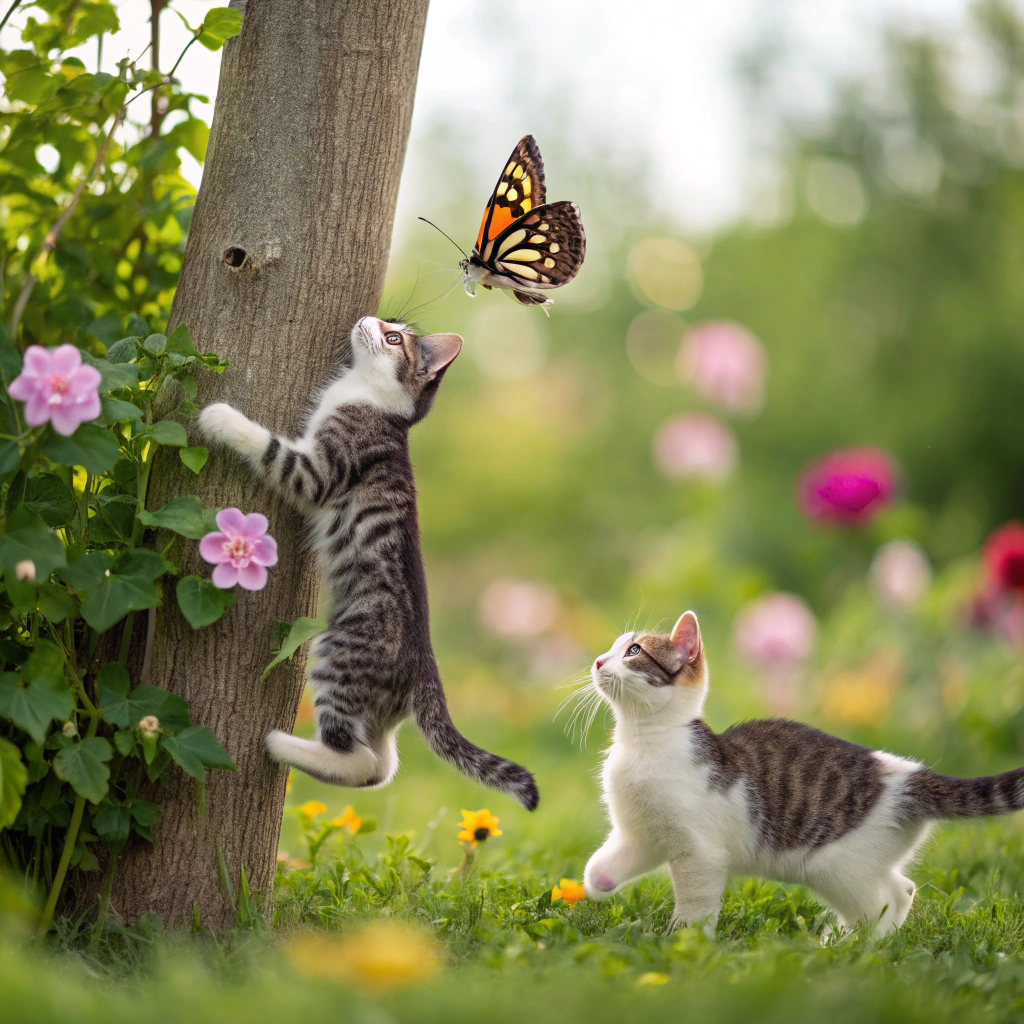Cats Live Outdoors: As a pet owner, you’re likely torn between giving your cat the freedom to explore the outdoors and ensuring their safety. While cats are naturally inclined to hunt and roam outside, there are several factors to consider before making a decision.

Letting your cat live outside can be a daunting decision, filled with concerns about their well-being and potential risks. However, with the right information, you can create a safer outdoor experience for your feline friend.
Understanding the implications of outdoor living for your cat is crucial. In this article, we’ll explore the seven crucial facts you need to know about letting your cat live outdoors, including potential risks, health considerations, and environmental impacts.
Key Takeaways
- Outdoor cats face various risks, including traffic accidents and diseases.
- Health considerations for outdoor cats include parasite infestations and injuries.
- The environmental impact of outdoor cats can be significant, affecting local wildlife.
- Creating a safe outdoor space can mitigate some risks.
- Understanding local regulations is essential for outdoor cat owners.
- Microchipping and identification are crucial for outdoor cats.
The Natural Behavior of Cats in Outdoor Environments
Cats exhibit unique behaviors when they are outdoors, driven by their instincts. When allowed to roam outside, domestic cats often display characteristics similar to their wild ancestors.Cats Live Outdoors
Fact1: Hunting and Territorial Instincts Remain Strong in Domestic Cats
Domestic cats retain their hunting instincts, which can lead them to stalk and catch small prey like rodents, birds, and insects. This natural behavior is a remnant of their wild ancestry, where hunting was essential for survival.Cats Live Outdoors
How These Instincts Affect Your Cat’s Outdoor Experience
These strong instincts can significantly impact your cat’s outdoor adventures. For instance, the urge to hunt can lead your cat to explore various territories, potentially exposing them to dangers such as traffic, other animals, or diseases.
| Instinct | Description | Potential Risks |
|---|---|---|
| Hunting | Stalking and catching small prey | Exposure to diseases, injuries from prey |
| Territorial Marking | Marking territory through scent and scratching | Conflicts with other animals, property damage |
Understanding these behaviors is crucial for cat owners to ensure their pets’ safety and the safety of local wildlife. By recognizing the natural behaviors of cats outdoors, you can take steps to mitigate potential risks.Cats Live Outdoors
Can Cats Live Outdoors Safely? Understanding the Risks
Cats that live outdoors are exposed to a range of hazards that can affect their lifespan and overall well-being. While some cats thrive in outdoor environments, many face significant risks that can impact their health and safety.Cats Live Outdoors

Fact2: Outdoor Cats Have Significantly Shorter Lifespans
Studies have shown that outdoor cats have substantially shorter lifespans compared to their indoor counterparts. The average lifespan of an outdoor cat is around 2-5 years, whereas indoor cats can live up to 15 years or more. This significant difference is largely due to the various dangers that outdoor cats encounter.Cats Live Outdoors
The reduced lifespan is attributed to factors such as accidents, diseases, and fights with other animals. Outdoor cats are more likely to be hit by vehicles, get into fights, or contract diseases from other infected animals.Cats Live Outdoors
Common Dangers That Threaten Outdoor Cats
Outdoor cats face numerous threats, including traffic accidents, predation by other animals, and exposure to harsh weather conditions. They are also at a higher risk of contracting diseases and parasites, such as fleas, ticks, and worms.Cats Live Outdoors
- Traffic accidents and being hit by vehicles
- Fights with other cats or animals, leading to injuries
- Diseases and parasites, such as rabies, feline leukemia, and fleas
- Poisoning from ingesting toxic substances
Understanding these risks is crucial for making an informed decision about whether to let your cat live outdoors. By acknowledging the potential dangers, you can take steps to minimize them and ensure your cat leads a longer, healthier life.Cats Live Outdoors
Health Considerations for Outdoor Cats
While the outdoors can be stimulating for cats, it also comes with considerable health concerns. Outdoor cats are more likely to be exposed to diseases and parasites due to their interaction with other animals, contaminated food and water, and various environmental factors.Cats Live Outdoors
Diseases and Parasites
Outdoor cats face a higher risk of contracting diseases such as rabies, feline leukemia, and feline immunodeficiency virus. Parasites like fleas, ticks, and worms are also more prevalent in outdoor cats. Regular check-ups and preventative care are crucial to mitigate these risks.

Essential Preventative Care
To keep your outdoor cat healthy, it’s essential to provide regular preventative care. This includes vaccinations against common diseases and parasite control measures such as flea and tick prevention. Regular veterinary check-ups can help identify health issues early on.
Vaccination and Medical Requirements
Vaccinations are a critical component of outdoor cat care. Ensure your cat is up-to-date on all necessary vaccinations, including those for rabies and other diseases. Additionally, consider spaying or neutering to reduce the risk of certain health issues and prevent unwanted breeding.
As emphasized by veterinarians, “Prevention is key when it comes to the health of outdoor cats.” By staying on top of your cat’s health needs, you can significantly reduce the risk of disease and ensure they lead a healthy life.
The Environmental and Community Impact
The decision to let your cat roam outdoors is not just about your pet’s freedom, but also about its impact on local wildlife. As a responsible cat owner, understanding the potential effects of your cat’s outdoor activities on the environment and your community is crucial.
How Outdoor Cats Affect Local Wildlife
Outdoor cats are known to hunt a variety of species, including birds, reptiles, and small mammals. This hunting instinct can lead to a significant decline in local wildlife populations. For instance, a study found that outdoor cats in the United States kill billions of birds and mammals annually.
| Wildlife Category | Estimated Annual Kill Rate by Outdoor Cats |
|---|---|
| Birds | 2.4 billion |
| Mammals | 1.4 billion |
| Reptiles and Amphibians | 230 million |
Neighborhood Considerations and Legal Responsibilities
Besides the environmental impact, outdoor cats can also affect your neighborhood dynamics. Some communities have laws and regulations regarding outdoor cats, including licensing requirements and rules about keeping cats contained. It’s essential to be aware of these regulations to avoid any legal issues.
By being mindful of your cat’s outdoor activities and taking steps to minimize its impact on the environment and community, you can help maintain a harmonious relationship between your pet and the surrounding ecosystem.
Creating Safer Outdoor Experiences for Your Cat
You can provide your cat with a safer outdoor experience by taking a few precautions. While cats are natural explorers, their outdoor adventures can be made more secure with the right measures.
Supervised Outdoor Time and Containment Options
One way to minimize risks is by providing supervised outdoor time. This can be achieved by accompanying your cat during their outdoor adventures or by creating a secure, enclosed area. Containment options such as cat enclosures or “catios” can provide a safe space for your cat to enjoy the outdoors.Cats Live Outdoors
Enrichment Alternatives to Free-Roaming
In addition to supervised outdoor time, you can also provide your cat with enrichment alternatives to free-roaming. This can include creating a cat-proofed yard or providing indoor activities that mimic outdoor experiences, such as interactive toys or climbing structures.Cats Live Outdoors
Catios, Enclosures, and Cat-Proofed Yards
Catios and enclosures are designed to provide a safe outdoor space for your cat, protecting them from potential dangers. A cat-proofed yard can also be an effective way to create a secure outdoor area. By implementing these measures, you can help ensure your cat’s outdoor experience is both enjoyable and safe.
Balancing Your Cat’s Needs with Safety
Letting your cat live outdoors requires careful consideration of several factors, including their natural behavior, potential risks, health needs, and environmental impact. By understanding these crucial facts, you can create a safer outdoor experience for your cat.Cats Live Outdoors
To ensure your cat’s outdoor cat health, it’s essential to provide preventative care, such as vaccinations and parasite control. Supervised outdoor time and containment options, like catios or enclosures, can also enhance outdoor cat safety.
By striking a balance between your cat’s needs and their safety, you can help them lead a happy, healthy life. Consider your cat’s individual needs and circumstances to make informed decisions about their outdoor access.Cats Live Outdoors
FAQ
Can cats live outdoors safely?
While some cats can thrive outdoors, many face significant risks that can impact their lifespan and overall health. To keep your cat safe, consider providing supervised outdoor time or containment options.
What are the risks associated with outdoor cats?
Outdoor cats are more likely to be involved in accidents, fight with other animals, and contract diseases. They may also be exposed to parasites, toxic substances, and extreme weather conditions.Cats Live Outdoors
How can I protect my outdoor cat from diseases and parasites?
Provide regular preventative care, including vaccinations and parasite control measures, to keep your outdoor cat healthy. Consult with your veterinarian to determine the best health plan for your cat.Cats Live Outdoors
What is the impact of outdoor cats on local wildlife?
Outdoor cats can have a significant impact on local wildlife, particularly birds, reptiles, and small mammals. Consider taking steps to minimize your cat’s impact, such as providing alternative prey or keeping your cat indoors during peak hunting hours.Cats Live Outdoors
How can I create a safer outdoor experience for my cat?
Consider supervised outdoor time, containment options, and enrichment alternatives like catios, enclosures, and cat-proofed yards to minimize risks while providing your cat with mental and physical stimulation.
What are some alternatives to letting my cat roam freely outdoors?
You can create a cat-friendly outdoor space by building a catio or enclosure, or by cat-proofing your yard. These alternatives allow your cat to enjoy the outdoors while minimizing the risks associated with free-roaming.Cats Live Outdoors
How can I care for a feral cat or stray cat outdoors?
If you’re caring for a feral or stray cat, provide food, water, and shelter, and consider working with local animal welfare organizations to spay or neuter the cat and provide medical care.Cats Live Outdoors

